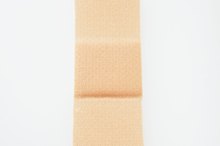Sand Burr Stickers and Skin Irritation
Sand burr, an unwelcome intruder in lawns and beaches throughout the Southern United States, is an annual grass that reproduces by burrs, or stickers. The burrs attach themselves to shoelaces, clothing, pet fur and even tires, and feature 1/4-inch spines that are sharp enough to penetrate skin. Although painful, the minor cuts that result from sand burrs sticking to your skin are usually not serious. However, stepping on a burr with bare feet can cause a puncture wound that should be seen by a doctor. Skin irritation from minor sand burr injuries can usually be treated with self care.
The Basics
The blades are an attractive light-green color, and the plant can be mistaken for turf grass until it begins featuring the burrs, which are 1/8 of an inch long and contain several seeds apiece. Because sand burr doesn't compete well with other plants, having a healthy, well-fertilized lawn is your first line of defense. Colorado Gardening reports that you can use a pre-emergence herbicide containing pendimethalin to prevent sand burr germination 2. Established sand burrs can be controlled with glyphosate, but this herbicide also kills desirable plants and must be carefully applied.
- The blades are an attractive light-green color, and the plant can be mistaken for turf grass until it begins featuring the burrs, which are 1/8 of an inch long and contain several seeds apiece.
- Established sand burrs can be controlled with glyphosate, but this herbicide also kills desirable plants and must be carefully applied.
First Aid for Sand Burr Injuries
Uses of Antiseptic Cream
Learn More
Treat small cuts and incisions from sand burrs by washing them with soap and water. Desert Exposure advises using a sterilized tweezers and running water to remove any spines or bits of organic debris that might have been left behind in your skin. Cover the area with an antibiotic ointment and place a bandage over it to keep out bacteria. Consult your doctor if you experience any of these symptoms.
- Treat small cuts and incisions from sand burrs by washing them with soap and water.
- Desert Exposure advises using a sterilized tweezers and running water to remove any spines or bits of organic debris that might have been left behind in your skin.
Soothing Skin Irritation from Sand Burrs
Even when sand burr spines don't cause:
- cuts
- contact with them can leave skin scratched
- irritated
- tender,
- itchy
If you have been exposed to a number of sand burrs, a soothing oatmeal bath can help relieve irritation. Dr. Howard Donsky, a staff dermatologist at Toronto General Hospital in Toronto, advises adding two cups of powdered, uncooked oatmeal to a lukewarm bath. The Doctor's Book of Home Remedies reports that it is also safe to use a topical over-the-counter hydrocortisone cream in a formulation of one-half percent. University of Maryland Medical Center says a cream or ointment made from menthol, the active ingredient in peppermint, can be applied to irritated skin up to four times a day 3. If you experience a rash, discontinue use.
- Even when sand burr spines don't cause: * cuts
* contact with them can leave skin scratched
* irritated
* tender,
* itchy If you have been exposed to a number of sand burrs, a soothing oatmeal bath can help relieve irritation. - University of Maryland Medical Center says a cream or ointment made from menthol, the active ingredient in peppermint, can be applied to irritated skin up to four times a day 3.
Puncture Wounds from Sand Burrs
How Can I Make My Scratches Heal Fast?
Learn More
To treat a small puncture wound from a sand burr, Mayoclinic.com advises first applying gentle pressure with a clean cloth to stop any bleeding. Generally, puncture wounds don't bleed heavily. Rinse the wound with clear water and use sterilized tweezers to remove particles. Follow with antibacterial ointment and a bandage and watch for signs of infection. If spikelets or bits of the burr remain in a puncture wound, see your doctor. MayoClinic.com cautions that you should also see your doctor for evaluation and treatment If the puncture wound is in your foot. If the puncture wound is deep and you have not had a tetanus shot in the past five years, your doctor might recommend a booster shot.
- To treat a small puncture wound from a sand burr, Mayoclinic.com advises first applying gentle pressure with a clean cloth to stop any bleeding.
Related Articles
References
- The Book of Field and Roadside -- Open-Country Weeds, Trees and Wildflowers: John Andrew Eastman
- University of Maryland Medical Center: Peppermint
- Fatigba HO, Allodé AS, Savi de tové KM, Mensah ED, Hodonou AM, Padonou J. The exploratory burr hole: indication and results at one departmental hospital of benin. ISRN Surg. 2013;2013:453907. Doi: 10.1155/2013/453907
- Lee HS, Song SW, Chun YI, et al. Complications Following Burr Hole Craniostomy and Closed-System Drainage for Subdural Lesions. Korean J Neurotrauma. 2018;14(2):68–75. doi:10.13004/kjnt.2018.14.2.68
- Eaton J, Hanif AB, Mulima G, Kajombo C, Charles A. Outcomes Following Exploratory Burr Holes for Traumatic Brain Injury in a Resource Poor Setting. World Neurosurg. 2017;105:257–264. doi:10.1016/j.wneu.2017.05.153
- Brain Surgery Risks. University of Maryland Medical Center. Accessed March 2011. http://www.umm.edu/ency/article/003018ris.htm
Writer Bio
Carol Sarao is an entertainment and lifestyle writer whose articles have appeared in Atlantic City Weekly, The Women's Newspaper of Princeton, and New Millennium Writings. She has interviewed and reviewed many national recording acts, among them Everclear, Live, and Alice Cooper, and received her Master of Fine Arts degree in writing from Warren Wilson College.









